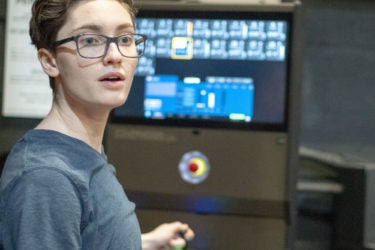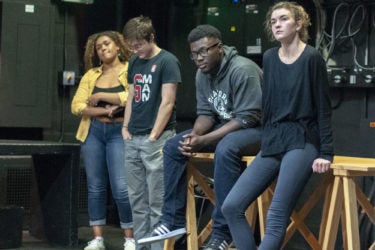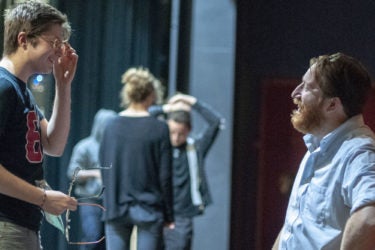Stanford’s Department of Theater and Performance Studies (TAPS) presents a contemporary adaptation of Anton Chekhov’s play The Seagull in the newly renovated Pigott Theater Thursday through Saturday, March 7-9.
The Seagull, Chekhov’s tragicomic masterwork written in 1895, follows a cast of idiosyncratic characters on a country lakeside estate as they navigate failures in love and art. Now, new technologies are helping Stanford students bring the classic play to life.
Students involved in the production are among the first to utilize new computer controlled motorized line sets that can be programmed to move the scenery and curtains and a lighting control network managed with touch screen controls – state-of-the-art theater technology that may be more advanced than what is found in some professional theaters. See video here.

Image credit: Courtesy Stanford TAPS
Image credit: Courtesy Stanford TAPS
Image credit: Courtesy Stanford TAPS

Image credit: Courtesy Stanford TAPS

Image credit: Courtesy Stanford TAPS

Image credit: Courtesy Stanford TAPS

Image credit: Courtesy Stanford TAPS

Image credit: Courtesy Stanford TAPS
In 1937, after a 15-year effort, the $587,000 Memorial Auditorium opened on the Stanford campus. The new facility housed a 1,700-seat theater that, according to the dramatic technical director at the time, was one of the largest school theaters in the United States. It was also home to a 200-seat venue called the Little Theater, renamed Pigott Theater in 2000 after Stanford alumnus Mark Pigott. The late professor Carl Weber, the eminent director who brought German experimental theater to America and taught at Stanford from 1985 to 2013, used to compare Pigott to the stage of the famous Berliner Ensemble in Berlin, Kleines Haus, which is high praise in the theater world.
“Pigott is a gem of a theater,” said Branislav Jakovljevic, professor and chair of the Department of Theater and Performance Studies in the School of Humanities and Sciences. “We are taking full advantage of this proscenium theater, which for TAPS students and faculty is much more than a performance space: it is a classroom, a laboratory and an indispensable tool in the education of young actors, directors, designers and theater-makers of all stripes.”
Winter quarter course
The Seagull is the culminating product of Assistant Professor Michael Rau’s winter acting course Undergraduate Performance Project where the assignment was to study and perform a major dramatic work. To that end, students learned to form an artistic ensemble, develop dramaturgical materials, learn professional arts protocols and practice, and develop live performance ability.
For senior Jamie Tippett, who has been involved in theater on and off campus for several years and is the assistant technical director for The Seagull, the best thing about the renovated theater is the ability to safely move line sets with the press of a button. “Just the other day in rehearsal, I watched someone working alone do complex, multiple line set moves all at once. Not only has the line set technology allowed for dynamic set changes during the show of The Seagull, but it has also allowed for the ease of hanging lights and speakers prior to the show. The time that has been saved by having these new line sets allows for more interesting and valuable learning opportunities,” he said.
Rau has been surprised and delighted by the nearly noiseless set changes that contribute to the audience experience. “Erik Flatmo, lecturer in TAPS and the set designer for The Seagull, created a series of walls that gradually enter into the space and create a smaller box within the larger theater, which contributes conceptually to the play,” Rau said. “Characters progress through the play and their world becomes smaller and more confined. The new rigging system allow us to quietly fly in walls and create that smaller, more closed-off world without distracting the audience with the sounds of old equipment.”
Safer, easier lighting
One of the consultants on the Pigott renovation project was Heather McAvoy, ’83, principal at the theater planning and lighting design firm Schuler Shook. She remembers the antiquated rigging system in Pigott. “As a drama major at Stanford, I was the lighting designer for several shows in Pigott, then called Little Theater, nearly 40 years ago. Hanging lights and scenery was very laborious back then because the original manual, counterweighted rigging system was double-purchase, which helped mitigate the low fly tower height, because for every foot of arbor travel, there are two feet of batten travel. But a double-purchase system requires two pounds of counterweight on the arbor to counterbalance one pound of weight on the batten, so that was a lot of iron to slog around, which is probably why I had great upper body strength back then!
“I was so happy to be a part of the design team for this renovation. The new motorized system is so much easier and safer to use – no loading of weights at all. I’m sorry for the current students, though. They’ll just have to go to the gym to get their workout,” she said.
Stanford’s Land, Buildings & Real Estate group (LBRE), the operational core of the physical campus, managed the Pigott renovation. According to Scott Pinson, project manager with zone management, the most challenging part of the renovation was completing a six-month construction project in three months due to the constant use of Memorial Auditorium for events including new student orientation and commencement. He said, “The renovation was also a product of three previous years of projects including major electrical infrastructure work, ADA restroom upgrades and extensive fire protection improvements which were needed before the rigging renovation. It makes it all worth it though when students, staff and faculty come up to me and thank me for the hard work our team has done to give them a modern, technologically advanced theatrical space. They are thrilled with the results.”